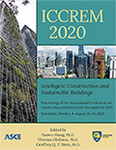International Conference on Construction and Real Estate Management 2020
Construction Workers’ Behavior Assessment Using 3D Visualization and Fuzzy Logic Method
Publication: ICCREM 2020: Intelligent Construction and Sustainable Buildings
ABSTRACT
Construction workers’ unsafe behaviors account for a large percentage of occupational injuries in construction industries. These inappropriate behaviors are commonly identified as having high ergonomic risk resulting from awkward postures, repetitive tasks, and excessive manual material handling. To facilitate ergonomic risk identification and the subsequent mitigation, an enhanced version of automated post-3D visualization ergonomic analysis has been developed with the integration of a proposed fuzzy logic-based joint-level ergonomic risk assessment methodology for work modification and workplace design. The proposed method aims to accurately and efficiently assess the construction workers’ behaviors for the development of ergonomic-centric workplace design prior to real-world implementation. It is validated through an experiment involving a lifting task using an optical marker-based motion capture system. With the integrated fuzzy logic method, the results of the enhanced system illustrate a higher level of accuracy and reliability through three levels of comparison and sensitivity analysis. By using the developed method, users can easily and quickly evaluate workers’ behaviors and consequently accomplish their desired ergonomic-centric workplace design to prevent and reduce work-related musculoskeletal disorders in construction.
Get full access to this article
View all available purchase options and get full access to this chapter.
REFERENCES
Bureau of Labor Statistics. (2016). “Nonfatal occupational injuries and illnesses requiring days away from work.” https://www.bls.gov/news.release/pdf/osh2.pdf>(2015).
Eichelberger, P., Ferraro, M., Minder, U., Denton, T., Blasimann, A., Krause, F. and Baur, H. (2016). “Analysis of accuracy in optical motion capture – A protocol for laboratory setup evaluation.” Journal of Biomechanics, 49(10), 2085-2088.
Golabchi, A., Han, S. and Fayek, A.R. (2016). “A fuzzy logic approach to posture-based ergonomic analysis for field observation and assessment of construction manual operations.” Canadian Journal of Civil Engineering, 43(4), 294-303.
Hignett, S. and McAtamney, L. (2010). “Rapid entire body assessment.” Handbook of Human Factors and Ergonomics Methods, 31(8), 8-11.
Janowitz, I.L., Gillen, M., Ryan, G., Rempel, D., Trupin, L., Swig, L., Mullen, K., Rugulies, R. and Blanc, P. D. (2006). “Measuring the physical demands of work in hospital settings: design and implementation of an ergonomics assessment.” Applied Ergonomics, 37(5), 641-658.
Kee, D. and Karwowski, W. (2007). “A comparison of three observational techniques for assessing postural loads in industry.” International Journal of Occupational Safety and Ergonomics, 13(1), 3-14.
Levanon, Y., Lerman, Y., Gefen, A. and Ratzon, N.Z. (2014). “Validity of the modified RULA for computer workers and reliability of one observation compared to six.” Ergonomics, 57(12), 1856-1863.
Li, X., Han, S., Gül, M., Al-Hussein, M. and El-Rich, M. (2018). “3D visualization-based ergonomic risk assessment and work modification framework and its validation for a lifting task.” Journal of Construction Engineering and Management, 144(1), 17-93.
Li, X., Han, S.H., Gül, M. and Al-Hussein, M. (2019). “Automated post-3D visualization ergonomic analysis system for rapid workplace design in modular construction.” Automation in Construction, 98(11), 160-174.
McAtamney, L. and Corlett, E.N. (1993). “RULA: A survey method for the investigation of work-related upper limb disorders.” Applied Ergonomics, 24(2), 91-99.
Rey, M.I., Galende, M., Fuente, M.J. and Sainz-Palmero, G.I. (2017). “Multi-objective based fuzzy rule based systems (FRBSS) for trade-off improvement in accuracy and interpretability: A rule relevance point of view.” Knowledge-Based Systems, 127(3), 67-84.
Wang, D., Dai, F. and Ning, X. (2015). “Risk assessment of work-related musculoskeletal disorders in construction: State-of-the-art review.” Journal of Construction Engineering and Management, 141(6), 8-15.
Zadeh, L.A. (1965). “Fuzzy sets.” Information and Control, 8(1), 338-353.
Information & Authors
Information
Published In
ICCREM 2020: Intelligent Construction and Sustainable Buildings
Pages: 47 - 54
Editors: Yaowu Wang, Ph.D., Harbin Institute of Technology, Thomas Olofsson, Ph.D., Luleå University of Technology, and Geoffrey Q. P. Shen, Ph.D., Hong Kong Polytechnic University
ISBN (Online): 978-0-7844-8323-7
Copyright
© 2020 American Society of Civil Engineers.
History
Published online: Oct 14, 2020
Published in print: Oct 14, 2020
Authors
Metrics & Citations
Metrics
Citations
Download citation
If you have the appropriate software installed, you can download article citation data to the citation manager of your choice. Simply select your manager software from the list below and click Download.
